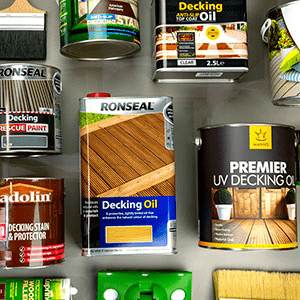Woodworm Treatment FAQ's
How do you treat woodworm in furniture?
Woodworm infestation in furniture can be recognised by small round holes on the surface of the timber and the gritty bore-dust that is left behind. These holes are most likely to be found near joints or on the undersides or backs of furniture. If the furniture has a surface coating such as paint or varnish, the thorough advice is to completely strip the furniture by sanding or stripping then treating with a woodworm killer such as Barrettine Premier Woodworm Killer Spray or Cuprinol Woodworm Killer (WB). However, some customers just treat the affected area and re-coat or paint.
Help needed on how to treat woodworm in painted wood?
Any previous finish such as varnish, stain or paint should be completely removed prior to treating with a woodworm treatment. Once the woodworm treatment has been applied to all areas and allowed to dry, the wood can be re-coated or painted. Some people manage by only removing the paint from the affected area then treating. The potential problem with this is that the woodworm may have penetrated further than the area treated, and the re-finished area may not totally blend in with the old finish.
How do I know when I need to use woodworm treatment?
Active insect attack can be recognised by small round holes on the surface of the timber and small piles of dust.
What is the difference between a woodworm treatment and a woodworm killer?
In some cases, manufacturer's simply call their products different things, either woodworm killer or woodworm treatment. This said, some products are more specific to killing off existing infestations whilst others are geared towards preventing future attack.
If unsure as to whether you have an active infestation or just old woodworm damage, our advice would be to use a woodworm killer first, then a wood preservative after. This will kill off any existing infestations and will also help to protect the wood against future attack. most wood preservatives also protect against mould and algae.
Does Teak oil kill woodworm?
Woodworm won't 'enjoy' being covered in Teak Oil per se but no, Teak oil will not kill woodworm. If you have active woodworm or wood boring insects a woodworm killer such as Barrettine Premier Woodworm Killer or Ronseal Woodworm Killer must be used to eradicate the infestation. Once treated, a suitable wood preservative should be used to help prevent future infestations.
What kills woodworm?
The most common insecticide used to control woodworm is Permethrin though growth inhibitors are used by some manufacturers. Permethrin is found in most woodworm killers.
When do woodworm hatch, do I have a time frame on when to treat?
Typically starting between May & September which is the adult emergence season for Woodworm. The woodworm should be treated as soon as possible to avoid the beetle laying larvae and the lifecycle recurring.
Are there different types of wood worm and if so will one woodworm treatment treat all?
There are several types of woodworm in the UK. All species will be killed with any of the woodworm treatments from our range.
Will damp wood make woodworm thrive, do I need a woodworm treatment and damp/mold treatment?
Generally speaking, woodworm do prefer damp wood. A Woodworm treatment should be used to eradicate any existing infestations then a wood preservative to protect against re-infestation, ensuring effective protection for years to come.
Mould needs to be treated separately with a dedicated mould and mildew cleaner. Once all traces of mould have been removed, and the wood has been allowed to dry, a wood oil, varnish, paint or other type of wood finish can be applied to protect the wood and complete the project.
Is woodworm treatment smelly or harmful to pets/children?
There are many woodworm treatments on the market from different brands. Some are suitable for both interior and exterior use whilst other are formulated for just interior use so take care to select the appropriate one. Most wooden surfaces such as floors, doors, furniture and wooden beams are over-coated once treated with a wood oil, wax, paint or varnish to ensure there is no direct contact with the wood. However, wooden surfaces treated with a woodworm killer are safe for pets and children once the treatment has fully dried.
In terms of smell, this is largely down to if the woodworm treatment is solvent-based or water-based. Solvent based products usually have a high VOC so therefore have a much stronger smell than the water-based equivalents.
Is there a guarantee that woodworm treatment will work?
Woodworm killers are specifically formulated to kill woodworm, wood boring insects, their larvae and eggs. As long as the woodworm killer is used following the manufacturer’s instructions, the manufacturer’s guarantee that their product will work. Basically, if the larvae are covered then they will die. It's important to treat all areas.
What is the best woodworm preventative and treatment?
As a preventative treatment, look for a wood preservative that specifically states that it prevents woodworm (some don't). For interior timbers we recommend Cuprinol 5 Star Complete Wood Treatment (WB) which is a low odour water-based formulation. For exterior timbers, we recommend Barrettine Premier Wood Preservative.
To eradicate existing woodworm infestations, we recommend Cuprinol Woodworm Killer (WB) for interior timbers and Barrettine Premier Woodworm Killer for exterior timbers.
How do you know if woodworm treatment has worked.
Wood boring insects tend to be more active during the warmer months of the year and if you have wood that has been or is impacted by woodworm, one of the best way to tell is by leaving a sheet of paper under the effected wood. If the woodworm is active you will find small piles of wood dust on the paper.
Barrettine Woodworm Killer kills all common insects, including Common Furniture Beetle, House Longhorn Beetle, Powder Post Beetle, wood boring Weevils their larvae and eggs.
Under stair treads, woodworm holes and chewed edges, and black dust on floor in same line as long edges of stair treads. If permethrin is being sprayed should I remain in house to ventilate after treatment or vacate the property. The property is currently empty and unoccupied.
Always wear the appropriate, protective clothing and face mask when applying woodworm treatments. The property should be well ventilated during and after application. Drying time from last coat is usually around 6- 8 hours at this time of year but is also dependent on the woodworm treatment being used. The treated wood should be left for 48 hours before applying any top-coat such as a paint, oil or varnish.
Permethrin is not dangerous to humans in these small doses, and you should be able to continue working in the property if required. This said however, always read the guidelines, instructions and advice given by the manufacturer on the product packaging before use.
Advice needed on how to treat woodworm in floorboards?
Wearing gloves and a mask, decant a woodworm treatment into a suitable container. Lift the floorboards and treat the joists and headers, treat the underneath, top, sides and ends of the floorboards.
Disclaimer: Whilst every attempt has been made to provide product information that is as accurate as possible, it's important to clarify that trees and the wood that they produce can be affected by many factors. For example, the same species of tree grown in the same wood, even in close proximity, will be affected by age along with the amount of sunlight and water they receive. Other naturally occurring biological and environmental factors will also influence the density and grain of the wood as well as the moisture and oil content of the timber. No two trees are the same, meaning each piece of wood has the potential to look and react differently to the same wood finish. For example, product adhesion, colour variations, absorption rates and sheen levels. It is for this reason that we always strongly recommend carrying out test areas before starting any project


